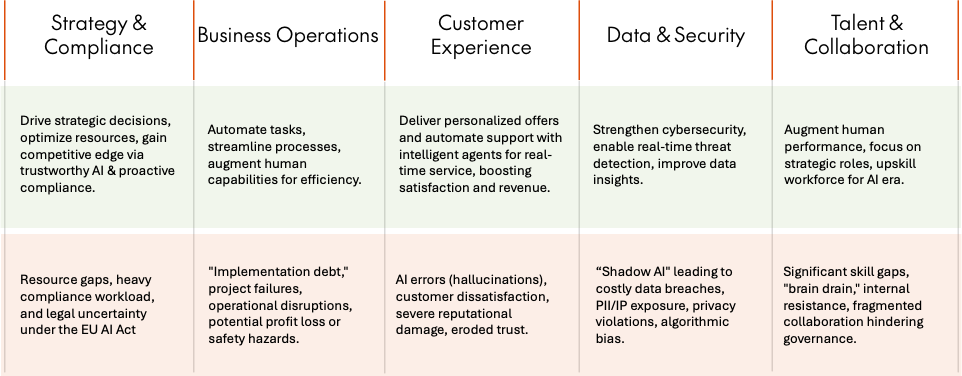The Missed Opportunity That Sparked the Conversation
We were working with a global industrial manufacturer to solve a long-standing pain point: ensuring product information was delivered accurately and consistently in multiple languages.
The challenge wasn’t just about efficiency — it was also critical for meeting strict compliance requirements.
Then came the surprise. A colleague turned to me and said:
“Christian, we can’t do that. The client has cut off access to OpenAI in their network.”
That single sentence revealed two critical truths about AI in today’s business environment:
- Shadow AI is inevitable — if employees see value in AI tools, they’ll find ways to use them, even if official access is blocked.
- Lack of AI strategy and governance is costly — in this case, a practical, compliance-improving solution was stopped before it even started.
The Rise of Shadow AI and Growing Compliance Pressure
Blocking AI platforms might seem like a quick risk-control measure, but it often creates more problems than it solves.
When official access is cut off, employees turn to unapproved workarounds — from personal devices to consumer-grade AI apps — leading to what’s now widely known as shadow AI.
Recent studies highlight the scale of the problem – and the opportunity:
- A Bitkom (2024) survey indicates that AI adoption in the German economy is accelerating. For the first time, more than half of companies (57%) are engaging with AI, and 20% are already using it. This marks a significant increase from 15% a year prior and just 9% in 2022.
- Bitcom also reports, over 60% of SMEs in Germany have no complete overview of which AI tools are being used within their company.
- Eurostat data shows a clear trend of AI adoption increasing with firm size. Large firms are adopting AI at a rate that is three to five times faster than small firms.
- An IBM study found that one in five organizations reported a data breach that was directly linked to the use of “shadow AI”—AI tools used without employer approval or oversight.
- The same IBM study revealed that two-thirds of organizations globally do not have an AI governance process in place, and only 37% have policies to detect or manage shadow AI.
- A Deloitte report highlights that regulation and risk have emerged as the top barriers to the development and deployment of Generative AI, with these challenges increasing by 10 percentage points from Q1 to Q4.
- Recent research from S&P Global reveals that 42% of companies now abandon the majority of their AI initiatives before reaching production — a dramatic surge from just 17% the previous year.
- The Stanford University AI Index Report 2025 notes that up to 61% of companies report a cost decrease and up to 70% report a revenue increase from AI usage.
- A PwC analysis of job advertisements found that productivity growth has quadrupled in AI-exposed industries, rising from 7% (2018–2022) to 27% (2018–2024).
The takeaway: Without a proper AI Governance process, you can’t manage AI risk — and you can’t fully capitalize on the innovation AI offers.
Balancing AI Opportunities and Risks in Your Organization
AI is now influencing almost every function in modern organizations — from customer engagement and supply chain management to HR, compliance, and product innovation. This creates vast opportunities for efficiency, growth, and competitive advantage. Yet without AI Governance, these same systems can expose the organization to compliance breaches, security vulnerabilities, and reputational risk.
The table below highlights key opportunities and risks associated with AI adoption. Recognizing this balance is essential for leaders who want to unlock AI’s potential while maintaining control. With the right AI Governance framework, organizations can capture the benefits, manage the risks, and ensure AI adoption remains responsible and sustainable.

Best Practices for Implementing AI Governance
From our work with enterprise and mid-market clients, these five steps consistently deliver results:
1. Conduct an AI Inventory
Map all AI tools currently in use — both approved and unapproved — to create the foundation for decision-making.
2. Define Clear Governance Roles
Assign ownership for AI compliance, risk management, and technical integration. AI Governance is not an IT-only responsibility — it’s cross-functional.
3. Establish Guardrails Without Stifling Innovation
Set guidelines on data usage, acceptable AI platforms, and risk thresholds, but leave room for experimentation within safe boundaries.
4. Integrate Compliance from the Start
Design governance to meet EU AI Act, GDPR, and industry regulations early — not as an afterthought.
5. Enable Continuous Improvement
Treat AI governance as a living system. Review performance regularly, update policies, and adapt to emerging technologies and regulations.
From Risk Control to Strategic Advantage
The manufacturer’s story is a cautionary tale — but also a missed opportunity.
AI Governance isn’t just about avoiding fines or keeping regulators happy.
It’s about unlocking AI’s potential while protecting your customers, your data, and your reputation.
With the right governance in place, you can:
- Turn shadow AI into a controlled innovation channel
- Meet compliance obligations without slowing down your teams
- Build trust with customers, partners, and regulators
- Make better, faster, and more consistent decisions across your business
Take Control of Your AI Future
At Verged, our 5-phase AI Governance framework gives you a clear path from vision to continuous improvement — combining strategic clarity, robust compliance, and the flexibility to innovate.
Ready to transform AI from a risk into a competitive advantage?
Explore our AI Governance Services ›

